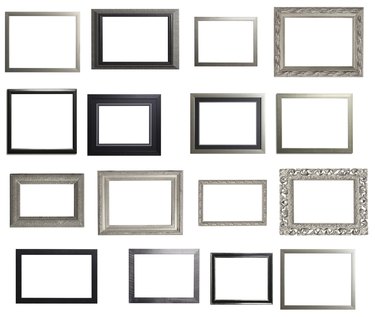
Those outdated or ugly metal picture frames may have come from your basement or a thrift-store bargain bin, but there's no reason to leave them with less-than-lovely looks. Update the mundane or monstrous metal frames with much needed paint makeovers, transforming them into picture-perfect creations that suit your home decor and style.
Preparing for Primer and Paint
Video of the Day
Remove the glass and back from the frame, otherwise they may be damaged. Sand the frame gently with a fine-grit sanding block or sandpaper. A sanding block conforms slightly to grooves or curves on the frame. Wipe the frame afterward with a slightly damp cloth, and then wipe it dry with another cloth, if necessary.
Video of the Day
Prime Time
Primer helps ensure that the paint adheres to the metal, so the extra primer step required before painting the frame is worth your time. Spray primer creates a smooth finish, ideal for metal frames and metallic finishes. Choose a multisurface primer or metal primer for best results. If the frame looks like it may be brass, select a self-etching primer. Place the frame on a tarp or sheets of newspaper in a well-ventilated area, preferably outdoors. Shake the spray can for a minute or two, and then spray the frame with a light coat of primer, holding the can 12 to 18 inches away. Begin each burst slightly before the frame and end beyond the frame, otherwise you may end up with odd drips or thick blobs of primer on the frame. Allow the primer to dry as recommended on the paint can. Apply a second coat, if necessary, allowing it to dry as well.
Painting the Frame
Any standard spray paint adheres to metal, but select a quality brand to ensure sufficient coverage. While you can use a brush-on paint instead of spray, a spray version provides a smoother "factory" style finish, free from brush strokes, and it reaches between cracks, grooves and textural variations with ease. Paint in a well-ventilated area or outdoors, again holding the spray can 12 to 18 inches away. Start each blast of paint before the frame and end beyond the frame, overlapping rows of paint slightly with each pass. Several thin coats provide a better finish than one thick coat. Allow the frame to dry for a full day before replacing the back and the glass, otherwise they may stick to the paint.
Perk Up the Paint
For specialty finishes such as an antique white or aged pewter, add a tinted glaze or a thinned paint in shades such as burnt sienna over white or charcoal gray over pewter. Brush the top glaze or paint randomly over the painted frame, and then rub most of the paint or glaze off right away with a soft cloth. The top translucent color collects within details, cracks and crevices on the frame and makes the piece look much older than it is. For a brushed metal or textural effect, dip the tip of a paintbrush into a paint color such as silver for a black or dark gray frame, wiping most of the paint off onto a paper towel. Dry-brush the paint over the frame, first in one direction, then another. Allow the top shade to dry completely before handling.